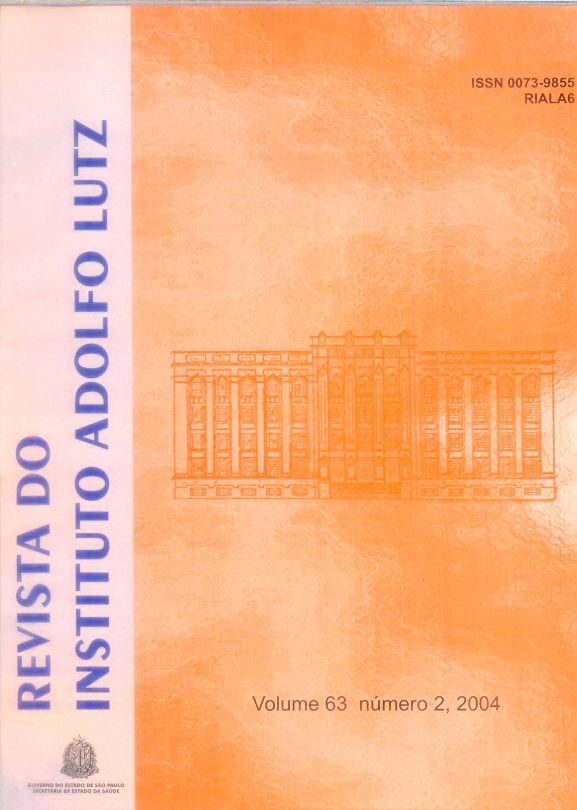Resumo
As várias espécies do gênero Curcuma têm sido estudadas desde a década de 60, pois há muito são amplamente cultivadas e utilizadas na medicina popular de todo sudeste asiático. Hoje seu uso é bem difundido entre nós e, apesar da utilização de várias técnicas para a caracterização dos extratos , o controle de qualidade desses fitoterápicos constitui um desafio para o laboratório de Saúde Pública. Este estudo propõe um método rápido e pouco dispendioso, empregando cromatografia em camada delgada e que mostrou-se eficaz na avaliação de extratos de Curcuma zedoaria.
Referências
1. Cao, H et al. Molecular analysis of medicinally-used Chinese and Japanese Curcuma based on 18S rRNA gene and trnK gene sequences. Biol. Pharm. Bull., 1: 1389-94, 2001.
2. Coimbra, R. Notas de Fitoterapia.2a ed., Edição do Laboratório Clínico Silva Araújo S.A., Rio de Janeiro, 1958.
3. Galand, N. et al. OPLC and AMD, recent techniques of planar chromatography: their interest for separation and characterization of extractive and synthetic compounds. Fitoterapia, 73: 121-34, 2002.
4. Gupta, S. K.et al. Isolation of Ethyl p-Methoxycinnamate, the major antifungal priciple of Curcuma zedoaria. Lloydia,39(4):218-22, 1976.
5. Hiermann, A ; Radl, B. Analysis of aromatic plant acids by capillary zone electrophoresis. J. Chromatog. A, 803: 311-4, 1998.
6. Hikino, H. et al. Structure of Curcumol. Chem. Pharm. Bull., 14 (11): 1241-49, 1966.
7. Hikino, H. et al. Structure of Curdione. Chem. Pharm. Bull., 15 (9): 1390-94, 1967.
8. Hikino, H. et al. Structure of Curcumenol. Chem. Pharm. Bull., 16: 39- 42, 1968.
9. Hikino, H. et al. Structure of Dehydrocurdione, a Serquiterpenoid of Curcuma zedoaria. Chem. Pharm. Bull., 20 (5): 987-9, 1972.
10. Hikino, H. et al. Structure of Zederone. Chem. Pharm. Bull., 16 (6): 1081-7, 1968.
11. Hikino, H. et al. Structure of Procurcumenol. Chem. Pharm. Bull., 16 (8): 1605-7, 1968.
12. Hikino, H. et al. Structure of Curcumol. Chem. Pharm. Bull., 16 (5): 827-31, 1968.
13. Hikino, H. et al. Furanodiene, a precursor of furan-containing sesquiterpenoids. Tetrahedron, 8: 931-3, 1968.
14. Hikino, H. et al. Structure of Curzerenone, Epicurzerenone and isofuranogermacrene. Tetrahedron, 24: 2855-8, 1968.
15. Hikino, H. et al. Sesquiterpenoids. Part XXXVII. Absolute Configuration and Conformation of Zederone, a Sesquiterpenoid of Curcuma zedoaria. J. Chem. Soc. (C): 688-91, 1971.
16. Kato, E.T.M..; Fisher, D.C.H. Estudo morfo-histológico e cromatográfico em camada delgada comparativo de raízes e de rizomas de Curcuma zedoaria (Bergius) Roscoe- droga, óleo essencial e extrato fluido. LECTA- USF, 14 (2): 9-26, jul./dez.1996.
17. Kim, K.I. et al. Antitumor, genotoxicity and anticlastrogenic activities of polysaccharide from Curcuma zedoaria. Mol. Cells. 31(4): 392-8, 2000.
18. Kim, K.I. et al. Effects of polyssaccharides from rhizomes of Curcuma zedoaria on macrophage functions. Biosci. Biotechnol. Biochem., 65(11): 2369-77, 2001.
19. Lee, H.; Lin, J.Y. Antimutagenic activity of extracts from anticancer drugs in Chinese medicine. Mutat. Res.,204(2):229-234, 1998.
20. Ma, H.Z. et al. Application of off-line supercritical-fluid extractiongas chromatography for the investigation of chemical-constituents in Curcuma zedoaria. Phytochem. Analysis, 6(6): 292-6, 1995.
21. Matsuda, H. et al. Inhibitory effect and action mechanism of sesquiterpenes from Zedoariae Rhizoma on D- galactosamine/lipopolysaccharide-induced liver injury. Bioorg. Med. Chem. Lett., 8(4):339-44, 1998.
22. Matsuda, H. et al. Hepatoprotective constituents from Zedoariae rhizoma: absolute stereostructures of three new carabrane-type sesquiterpenes, curcumenolactones A, B and C. Bioorg. Med. Chem., 9; 909-16, 2001.
23. Mello, M.O. et al. Quantificação da Micropropagação de Curcuma zedoaria Roscoe. Sci. Agric., 57(4): 703-7, 2000.
24. Miyake, E. T. Zedoária- Curcuma zedoaria Roscoe. Rev. Bras. Farmacogn., 1(2): 118-262, 1986.
25. Nadkarni, K.M. The Indian Materia Medica , Bombay, 1927.
26. Nyiredy, S. The bridge between TLC and HPLC: overpressured layer chromatography (OPLC). Trends Analyt. Chem., 20 (2): 91-101, 2001.
27. Poole, C.F., Dias, N. C. Practitioner’s guide to method development in thin-layer chromatography. J. Chromatog. A , 892: 123-42, 2000.
28. Poole, C.F. Planar chromatography at the turn of the century. J. Chromatog. A , 856:399-427, 1999.
29. Syu, W. J. et al. Cytotoxicity of curcuminoids and some novel compounds from Curcuma zedoaria. J. Nat. Prod., 61(12): 1531-4, 1998.
30. Takano, I. et al. Guaiane sesquiterpene lactones from Curcuma aeruginosa. Phytochemistry, 40(4): 1197- 2000, 1995.
31. Yoshioka, T. et al.. Antiinflamatory potency of dehydrocurdione, a zedoary-derived sesquiterpene. Inflamm. Res., 47(12):476-81, 1998.
32. Wagner, H.; Bladt, S. Plant drug analysis. Heidelberg, Springer-Verlag, 1996, 384 p.

Este trabalho está licenciado sob uma licença Creative Commons Attribution 4.0 International License.
Copyright (c) 2004 Mônica Arcon Batistic, Maria Aparecida Nicoletti, Mariangela Tirico Auricchio
